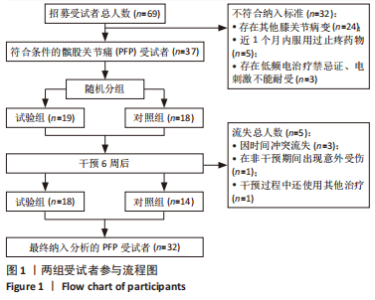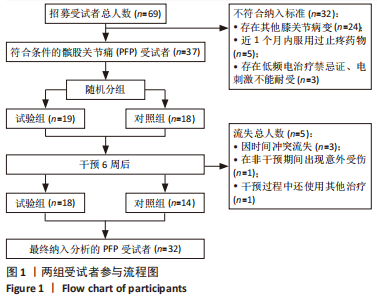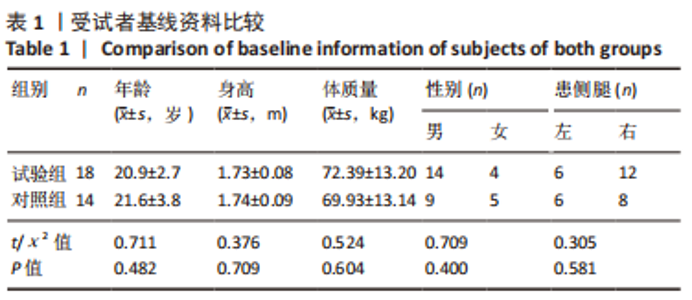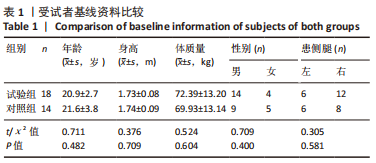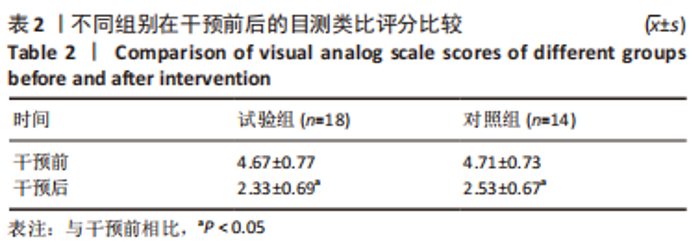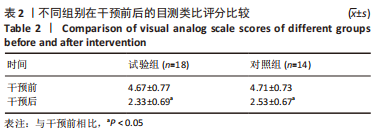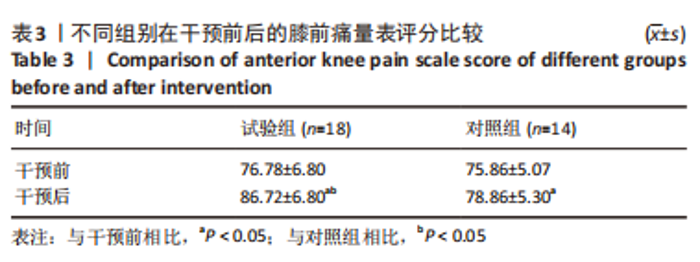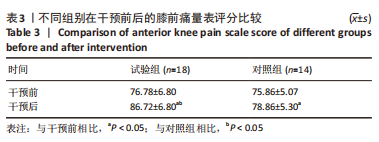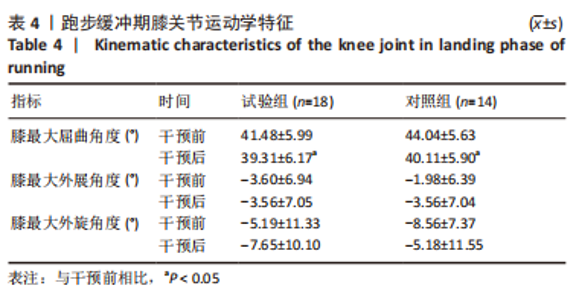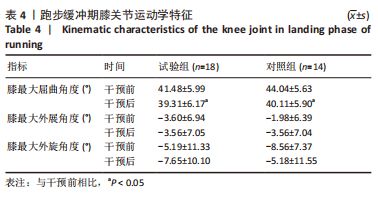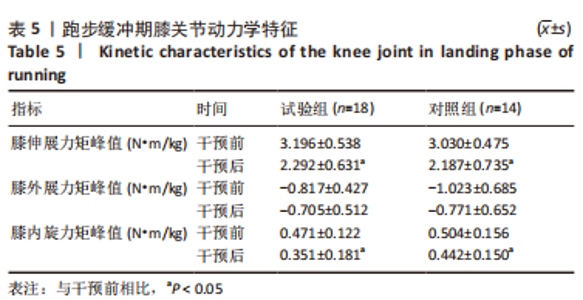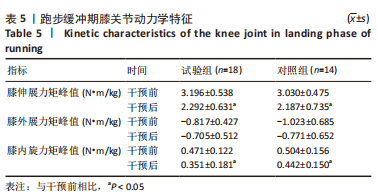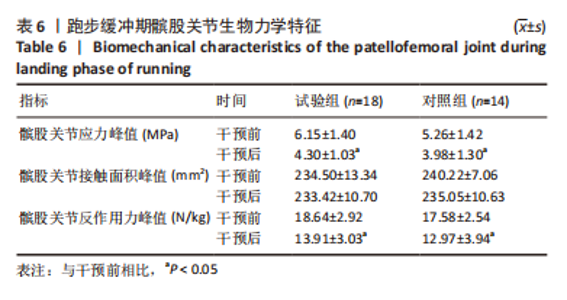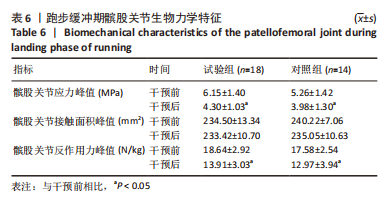Chinese Journal of Tissue Engineering Research ›› 2024, Vol. 28 ›› Issue (9): 1365-1371.doi: 10.12307/2024.036
Previous Articles Next Articles
Intervention of muscle strength training combined with neuromuscular electrical stimulation on lower limb function and biomechanical changes in patients with patellofemoral pain
Wu Jing1, Yao Yingce1, Yang Xiaowei1, Xue Boshi1, Zhao Jianbin1, Yang Chen2, Luan Tianfeng3, Zhou Zhipeng3
- 1Graduate School, 3College of Sports and Health, Shandong Sport University, Jinan 250102, Shandong Province, China; 2School of Sports and Health, Nanjing Sport Institute, Nanjing 210014, Jiangsu Province, China
-
Received:2023-02-15Accepted:2023-04-07Online:2024-03-28Published:2023-07-25 -
Contact:Zhou Zhipeng, PhD, Professor, College of Sports and Health, Shandong Sport University, Jinan 250102, Shandong Province, China -
About author:Wu Jing, Master candidate, Graduate School, Shandong Sport University, Jinan 250102, Shandong Province, China -
Supported by:2022 Shandong University Student Innovation Training Project, No. 1341 (to ZZP); Shandong Social Science Planning and Research Project, No. 20CTYJ17 (to LTF)
CLC Number:
Cite this article
Wu Jing, Yao Yingce, Yang Xiaowei, Xue Boshi, Zhao Jianbin, Yang Chen, Luan Tianfeng, Zhou Zhipeng. Intervention of muscle strength training combined with neuromuscular electrical stimulation on lower limb function and biomechanical changes in patients with patellofemoral pain[J]. Chinese Journal of Tissue Engineering Research, 2024, 28(9): 1365-1371.
share this article
Add to citation manager EndNote|Reference Manager|ProCite|BibTeX|RefWorks
| [1] ASHNAGAR Z, HADIAN MR, SAJJADI E, et al. Quadriceps architecture in individuals with patellofemoral pain: A systematic review. J Bodyw Mov Ther. 2021;25:248-254. [2] 杨辰,曲峰,刘卉,等.髌股关节痛业余跑者性别特异的下肢生物力学特征[J].医用生物力学,2020,35(6):672-678. [3] 陈一言,陆阿明.髌股疼痛综合征下肢动作模式特征与康复治疗研究进展[J].医用生物力学,2022,37(3):555-561. [4] CROSSLEY KM, STEFANIK JJ, SELFE J, et al. 2016 Patellofemoral pain consensus statement from the 4th International Patellofemoral Pain Research Retreat, Manchester. Part 1: Terminology, definitions, clinical examination, natural history, patellofemoral osteoarthritis and patient-reported outcome measures. Br J Sports Med. 2016;50(14):839-843. [5] LANKHORST NE, BIERMA-ZEINSTRA SM, VAN MIDDELKOOP M. Factors associated with patellofemoral pain syndrome: a systematic review. Br J Sports Med. 2013;47(4):193-206. [6] 杨辰,曲峰.髌股关节痛病因、治疗和分组的生物力学研究进展[J].中国运动医学杂志,2017,36(10):927-932. [7] SAKAI N, LUO ZP, RAND JA, et al. The influence of weakness in the vastus medialis oblique muscle on the patellofemoral joint: an in vitro biomechanical study. Clin Biomech (Bristol, Avon). 2000;15(5):335-339. [8] FINNOFF JT, HALL MM, KYLE K, et al. Hip strength and knee pain in high school runners: a prospective study. PM R. 2011;3(9):792-801. [9] FUKUDA TY, ROSSETTO FM, MAGALHAES E, et al. Short-term effects of hip abductors and lateral rotators strengthening in females with patellofemoral pain syndrome: a randomized controlled clinical trial. J Orthop Sports Phys Ther. 2010;40(11): 736-742. [10] MARTIMBIANCO ALC, TORLONI MR, ANDRIOLO BN, et al. Neuromuscular electrical stimulation (NMES) for patellofemoral pain syndrome. Cochrane Database Syst Rev. 2017;12(12):CD011289. [11] SAFRAN EE, MUTLUAY F, UZAY A. Effects of neuromuscular electrical stimulation combined with resistance exercises on muscle strength in adult hematological cancer patients: A randomized controlled study. Leuk Res. 2022;121:106932. [12] MATSUSE H, SEGAL NA, RABE KG, et al. The Effect of Neuromuscular Electrical Stimulation During Walking on Muscle Strength and Knee Pain in Obese Women With Knee Pain: A Randomized Controlled Trial. Am J Phys Med Rehabil. 2020;99(1):56-64. [13] GLAVIANO NR, MARSHALL AN, MANGUM LC, et al. Improvements in Lower-Extremity Function Following a Rehabilitation Program With Patterned Electrical Neuromuscular Stimulation in Females With Patellofemoral Pain: A Randomized Controlled Trial. J Sport Rehabil. 2020;29(8):1075-1085. [14] RULAND JR, III MMH, DIDUCH DR. Patellofemoral Pain: Current Concepts. Ann Sports Med Res. 2017;5(4):1118-1121. [15] RABELO ND, LIMA B, REIS AC, et al. Neuromuscular training and muscle strengthening in patients with patellofemoral pain syndrome: a protocol of randomized controlled trial. BMC Musculoskelet Disord. 2014;15:157. [16] GLAVIANO NR, HUNTSMAN S, DEMBECK A, et al. Improvements in kinematics, muscle activity and pain during functional tasks in females with patellofemoral pain following a single patterned electrical stimulation treatment. Clin Biomech (Bristol, Avon). 2016;32:20-27. [17] VAN DER HEIJDEN RA, LANKHORST NE, VAN LINSCHOTEN R, et al. Exercise for treating patellofemoral pain syndrome. Cochrane Database Syst Rev. 2015;1:CD010387. [18] GLAVIANO NR, MARSHALL AN, MANGUM LC, et al. Impairment-Based Rehabilitation With Patterned Electrical Neuromuscular Stimulation and Lower Extremity Function in Individuals With Patellofemoral Pain: A Preliminary Study. J Athl Train. 2019;54(3):255-269. [19] KOLLE T, ALT W, WAGNER D. Effects of a 12-week home exercise therapy program on pain and neuromuscular activity in patients with patellofemoral pain syndrome. Arch Orthop Trauma Surg. 2020; 140(12):1985-1992. [20] NUSSBAUM EL, HOUGHTON P, ANTHONY J, et al. Neuromuscular Electrical Stimulation for Treatment of Muscle Impairment: Critical Review and Recommendations for Clinical Practice. Physiother Can. 2017;69(5):1-76. [21] 万丽,赵晴,陈军,等.疼痛评估量表应用的中国专家共识(2020版)[J].中华疼痛学杂志,2020,16(3):177-187. [22] HOTT A, LIAVAAG S, JUEL NG, et al. The reliability, validity, interpretability, and responsiveness of the Norwegian version of the Anterior Knee Pain Scale in patellofemoral pain. Disabil Rehabil. 2021;43(11):1605-1614. [23] WU G, SIEGLER S, ALLARD P, et al. ISB recommendation on definitions of joint coordinate system of various joints for the reporting of human joint motion--part I: ankle, hip, and spine. International Society of Biomechanics. J Biomech. 2002;35(4):543-548. [24] DRAPER CE, BESIER TF, SANTOS JM, et al. Using real-time MRI to quantify altered joint kinematics in subjects with patellofemoral pain and to evaluate the effects of a patellar brace or sleeve on joint motion. J Orthop Res. 2009;27(5):571-577. [25] 权朝鲁.效果量的意义及测定方法[J].心理学探新,2003(2):39-44. [26] 祁钰杰,王琳.跑步再训练对髌股疼痛综合征跑者髌股关节压力的影响[J].浙江体育科学,2021,43(2):105-112. [27] LABANCA L, ROCCHI JE, CARTA N, et al. NMES superimposed on movement is equally effective as heavy slow resistance training in patellar tendinopathy. J Musculoskelet Neuronal Interact. 2022;22(4): 474-485. [28] CROSSLEY KM, BENNELL KL, COWAN SM, et al. Analysis of outcome measures for persons with patellofemoral pain: which are reliable and valid? Arch Phys Med Rehabil. 2004 ;85(5):815-822. [29] BILY W, TRIMMEL L, MODLIN M, et al. Training program and additional electric muscle stimulation for patellofemoral pain syndrome: a pilot study. Arch Phys Med Rehabil. 2008;89(7):1230-1236. [30] HU H, ZHENG Y, LIU X, et al. Effects of neuromuscular training on pain intensity and self-reported functionality for patellofemoral pain syndrome in runners: study protocol for a randomized controlled clinical trial. Trials. 2019;20(1):409. [31] CLAYTON EB, FORSTER A, PALASTANGA N. Clayton’s Electrotherapy: Theory and Practice. Bailliere Tindall Limited, United Kingdom, 1985. [32] ROBERTSON VJ, WARD AR. Vastus medialis electrical stimulation to improve lower extremity function following a lateral patellar retinacular release. J Orthop Sports Phys Ther. 2002;32(9):437-443. [33] JOHNSON M, MARTINSON M. Efficacy of electrical nerve stimulation for chronic musculoskeletal pain: a meta-analysis of randomized controlled trials. Pain. 2007;130(1-2):157-165. [34] KUJAWA M, GOERLITZ A, RUTHERFORD D, et al. Patellofemoral Joint Stress during Running with Added Load in Females. Int J Sports Med. 2020;41(6):412-418. [35] LABANCA L, ROCCHI JE, LAUDANI L, et al. Neuromuscular Electrical Stimulation Superimposed on Movement Early after ACL Surgery. Med Sci Sports Exerc. 2018;50(3):407-416. [36] TOTH MJ, TOURVILLE TW, VOIGT TB, et al. Utility of Neuromuscular Electrical Stimulation to Preserve Quadriceps Muscle Fiber Size and Contractility After Anterior Cruciate Ligament Injuries and Reconstruction: A Randomized, Sham-Controlled, Blinded Trial. Am J Sports Med. 2020;48(10):2429-2437. [37] BORZUOLA R, LABANCA L, MACALUSO A, et al. Modulation of spinal excitability following neuromuscular electrical stimulation superimposed to voluntary contraction. Eur J Appl Physiol. 2020;120(9): 2105-2113. [38] COLLINS NJ, BARTON CJ, VAN MIDDELKOOP M, et al. 2018 Consensus statement on exercise therapy and physical interventions (orthoses, taping and manual therapy) to treat patellofemoral pain: recommendations from the 5th International Patellofemoral Pain Research Retreat, Gold Coast, Australia, 2017. Br J Sports Med. 2018; 52(18):1170-1178. [39] HAGHIGHAT F, EBRAHIMI S, REZAIE M, et al. Trunk, pelvis, and knee kinematics during running in females with and without patellofemoral pain. Gait Posture. 2021;89:80-85. [40] TAKABAYASHI T, EDAMA M, INAI T, et al. A mathematical modelling study investigating the influence of knee joint flexion angle and extension moment on patellofemoral joint reaction force and stress. Knee. 2019;26(6):1323-1329. [41] CHIU JK, WONG YM, YUNG PS, et al. The effects of quadriceps strengthening on pain, function, and patellofemoral joint contact area in persons with patellofemoral pain. Am J Phys Med Rehabil. 2012;91(2):98-106. [42] WANG B, YANG Y, ZhANG X, et al. Twelve-Week Gait Retraining Reduced Patellofemoral Joint Stress during Running in Male Recreational Runners. Biomed Res Int. 2020;2020:9723563. [43] SHERMAN SL, PLACKIS AC, NUELLE CW. Patellofemoral anatomy and biomechanics. Clin Sports Med. 2014;33(3):389-401. [44] CELIK D, ARGUT SK, TURKER N, et al. The effectiveness of superimposed neuromuscular electrical stimulation combined with strengthening exercises on patellofemoral pain: A randomized controlled pilot trial. J Back Musculoskelet Rehabil. 2020;33(4):693-699. [45] AKARCALI I, TUGAY N, KAYA D, et al. The role of high voltage electrical stimulation in the rehabilitation of patellofemoral pain. Pain Clin. 2013;14(3): 207-212. [46] ALMONROEDER TG, BENSON LC. Sex differences in lower extremity kinematics and patellofemoral kinetics during running. J Sports Sci. 2017;35(16):1575-1581. [47] SINAEI E, FOROOZANTABAR V, YOOSEFINEJAD AK, et al. Electromyographic comparison of vastus medialis obliquus facilitatory versus vastus lateralis inhibitory kinesio taping in athletes with patellofemoral pain: A randomized clinical trial. J Bodyw Mov Ther. 2021;28:157-163. |
| [1] | Wang Juan, Wang Guanglan, Zuo Huiwu. Efficacy of exercise therapy in the treatment of anterior cruciate ligament reconstruction patients: #br# a network meta-analysis #br# [J]. Chinese Journal of Tissue Engineering Research, 2025, 29(8): 1714-1726. |
| [2] | Zhang Shuai, Li Zichun, Xu Yihao, Xie Xiaofeng, Guo Zhongsheng, Zhao Qingyang. Effect of transcranial magneto-acousto-electrical stimulation on the plasticity of the prefrontal cortex network in mice [J]. Chinese Journal of Tissue Engineering Research, 2025, 29(6): 1108-1117. |
| [3] | Gou Yanyun, Hou Meijin, Jiang Zheng, Chen Shaoqing, Chen Xiang, Gao Yuzhan, Wang Xiangbin. Biomechanical characteristics of walking in patients with idiopathic scoliosis: cross-sectional analysis of three-dimensional motion capture [J]. Chinese Journal of Tissue Engineering Research, 2025, 29(3): 471-477. |
| [4] | Wang Zilong, Meng Xin, Zhang Zhiqi, Xie Yu, Meng Lingyue, Zhang Qiuxia, Kong Lingyu. Biomechanical characteristics of lower extremities during counter movement jump in male patients with functional ankle instability [J]. Chinese Journal of Tissue Engineering Research, 2025, 29(3): 478-485. |
| [5] | Zheng Xiang, Zhang Mingxing, Huang Ya, Shan Sharui. Improvement of lower limb walking function in patients with chronic non-specific low back pain by biofeedback assisted electrical stimulation [J]. Chinese Journal of Tissue Engineering Research, 2025, 29(3): 547-553. |
| [6] | Zhang Jiale, Wang Fusen, Qiu Zhenrui, Fan Xinming, Zou Jilong, Bi Zhenggang, Sun Jiabing. Exercise therapy for the treatment of chronic nonspecific lower back pain through mechanical-chemical coupling [J]. Chinese Journal of Tissue Engineering Research, 2025, 29(11): 2377-2384. |
| [7] | Tan Xin, Zhang Hongyue, Zhao Yuchan, Qin Chun, Xu Shuogui. Application of shape memory alloys in assistive devices and rehabilitation equipment [J]. Chinese Journal of Tissue Engineering Research, 2025, 29(10): 2113-2123. |
| [8] | Qi Haodong, Lu Chao, Xu Hanbo, Wang Mengfei, Hao Yangquan. Effect of diabetes mellitus on perioperative blood loss and pain after primary total knee arthroplasty [J]. Chinese Journal of Tissue Engineering Research, 2024, 28(9): 1383-1387. |
| [9] | Zhang Xihui, Li Zhengrong, Li Shineng, Xing Zengyu, Wang Jiao. Effect of rehabilitation training guided by Pro-kin balance system on proprioception and balance function of the affected knee after anterior cruciate ligament reconstruction [J]. Chinese Journal of Tissue Engineering Research, 2024, 28(8): 1259-1264. |
| [10] | Zhang Ming, Wang Bin, Jia Fan, Chen Jie, Tang Wei. Application of brain-computer interface technology based on electroencephalogram in upper limb motor function rehabilitation of stroke patients [J]. Chinese Journal of Tissue Engineering Research, 2024, 28(4): 581-586. |
| [11] | Zhi Liang, Wang Yulong, Zhang Qingfang, Hong Yaqing, Ke Meihua, Liu Quanquan, Long Jianjun. Propulsion deficits in hemiplegic gait of stroke patients [J]. Chinese Journal of Tissue Engineering Research, 2024, 28(35): 5709-5715. |
| [12] | Sun Yiming, Yang Xinming, Cai Liqun, Liu Aining. Bibliometric analysis of vertigo-related histopathology, vestibular rehabilitation, physical rehabilitation, and Chinese and Western medical treatments [J]. Chinese Journal of Tissue Engineering Research, 2024, 28(34): 5500-5507. |
| [13] | Xu Yi, Deng Yubin. Exoskeleton-assisted walking rehabilitation for spinal cord injury: CiteSpace analysis of research hotspots [J]. Chinese Journal of Tissue Engineering Research, 2024, 28(33): 5403-5412. |
| [14] | Zhang Jinpu, Wang Junli, Zhang Siqi, Chen Jiahao, Yang Qiushi. Effectiveness of exercise interventions for fibromyalgia syndrome: a Meta-analysis [J]. Chinese Journal of Tissue Engineering Research, 2024, 28(32): 5210-5216. |
| [15] | Su Yuying, Li Wei, Shi Yu, Pan Changbo. Effects of different exercise interventions on symptoms and dynamic balance ability of chronic ankle instability: a systematic review and Meta-analysis [J]. Chinese Journal of Tissue Engineering Research, 2024, 28(32): 5217-5224. |
| Viewed | ||||||
|
Full text |
|
|||||
|
Abstract |
|
|||||
